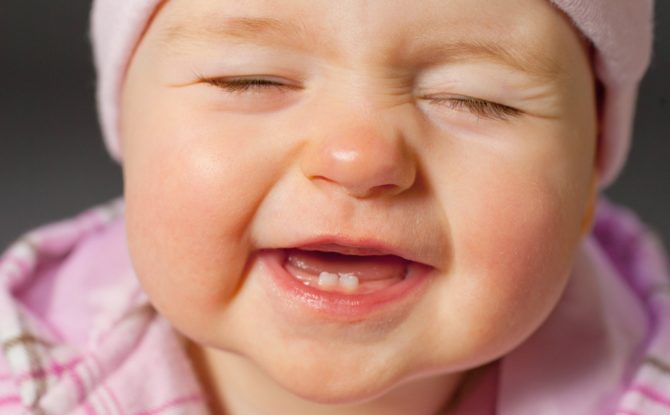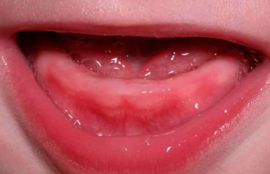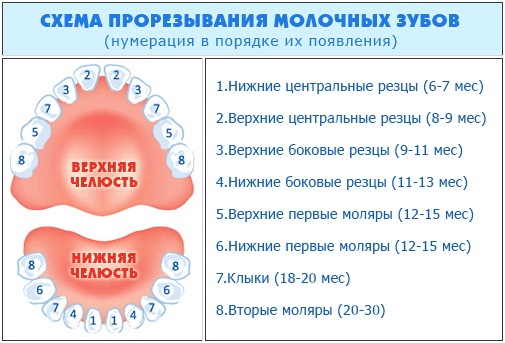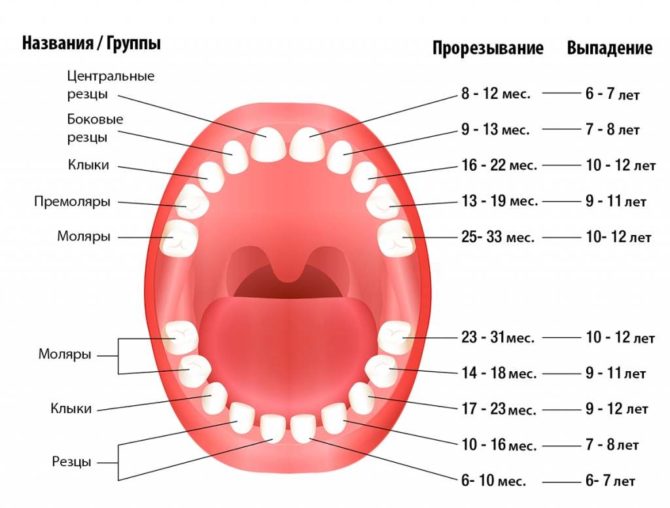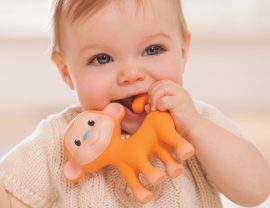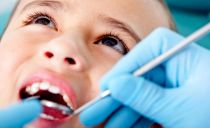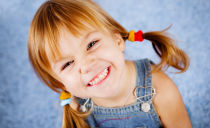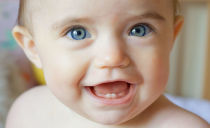Climbing a child’s teeth: symptoms, how to help a child and what can be done
A few months after the birth of the baby, a difficult period of teething begins for him. Experienced parents know how many problems this natural process can bring. During the teething period, the baby is not only naughty, but also has a weakened immunity, which is fraught with the addition of infection. therefore it is important to be able to distinguish the symptoms that occur when a child's teeth climb, from the signs of the disease that needs to be treated.
Content
Symptoms when a child climbs his teeth
About two months can pass from the beginning of the active formation of a tooth to its appearance on the surface of the gums. You can notice the preparation of the child's body for the appearance of teeth by the following signs:
-
The gum becomes inflamed due to trauma to a growing tooth, its surface turns red and swollen.
- The discomfort that "develops" in the gum is accompanied by increased salivation. There is so much saliva that you have to change your baby’s sweatshirts or bib several times a day due to getting wet.
- To alleviate the itching of the gums, the baby instinctively pulls into his mouth and nibbles any objects, including his own pens.
- Discomfort prevents the child from eating normally, so his appetite decreases. The rate of weight gain may slow down.
- At night, the itch continues to pester the baby, so its sleep becomes restless, often interrupted by crying.
Immediately before the crowns exit onto the gum surface, the symptoms intensify and new signs are added:
- Signs resembling an intestinal infection: rapid regurgitation and diarrhea, in some children - constipation.
- Symptoms resembling a respiratory infection: cough, runny nose and fever.
- Sometimes a rash appears on the cheeks.
- Directly when teething on the gums comes out blood.
The appearance of lower incisors and molars is accompanied by less noticeable symptoms. If upper teeth or fangs climb, discomfort may be more painful due to their anatomical features.
Teething procedure
There is no strict order according to which a child’s teeth should be climbed. The body of each baby is individual, so each child’s teeth can be cut in a different sequence. But most often, teething occurs according to this scheme:
- Central lower incisors.
- Central upper incisors.
- Side incisors.
- Fangs.
- The first molars.
- The second molars.
The teeth located in the front come out first, the rear ones are cut last. If the baby’s teeth are not climbing in the same sequence as his peers, one should pay attention to symmetry. For example, when one of the fangs erupts ahead of time, the second fang should appear immediately after it.
At what age do children climb teeth
For all children, teeth climb at different ages - there is no clear standard. Average babies can boast of the first incisors already in the seventh month of life. In some babies, teeth come out just 3 months after birth and even earlier - newborns sometimes are born with several teeth. Some infants begin to experience the moment of teething of the first incisor closer to the year.
Too early teeth come in babies whose mothers take vitamins and minerals in the form of medications during pregnancy. The same phenomenon occurs with hormonal abnormalities. At a later age, the dentition is formed with a lack of nutrients and some diseases. But panic ahead of time is not worth it, late teething is a hereditary feature, although it is still necessary to show the baby to the doctor.
In total, twenty baby teeth erupt in the child, and all of them should come to the surface by 2-3 years. Parents can maintain a teething calendar to compare their baby’s data with the average and contact a pediatric dentist if they are behind or ahead of schedule.
Deviations and their causes
If the child’s teeth do not “come out” as expected, parents should notice this in time. Some of the deviations require treatment, others require more careful monitoring of the health of the baby.
| Problem | Possible reasons | What to do to parents |
|---|---|---|
| Delayed teething. | Weak immunity, vitamin deficiency (rickets may occur), hormonal failure, malnutrition, late start of feeding, lack of rudiments of milk teeth. | Visit your pediatrician regularly to monitor development and weight gain. It is necessary to introduce complementary foods in a timely manner. With a long delay in teething, it is necessary to take tests for hormones and the presence of vitamin deficiency, as well as an x-ray of the jaw. |
| One of the teeth erupted, but not symmetrical to him. | Lack of anlage of tooth. | Contact your dentist for an examination. |
| The first teeth come out very early. | The effect of vitamin preparations used during pregnancy, hormonal failure in the body of the child. | Consult a pediatrician and get appropriate blood tests. |
| When the teeth are cut, the child is very naughty, loses weight. | Accession of infection, weak immunity. | Consult a doctor for examination and correction of the feeding schedule. |
| Temperature increase. | A characteristic symptom of teething or infection. | With severe fever - call a doctor and use a children's antipyretic. |
| Teeth come to the surface with destroyed enamel. | Enamel hypoplasia. | Consult a pediatrician to prescribe treatment for infection, endocrine or metabolic disorders. |
Causes of abnormalities that form during pregnancy
All the rudiments of the teeth should be properly formed during the period of intrauterine development. If a negative factor acts on the fetus during pregnancy, the teeth may not form at all, or their tissues will not be strong enough to perform their functions. This leads to:
- Alcoholism and smoking pregnant.
- Self-medication.
- The use of dangerous drugs, antibiotics.
- Poisoning.
- Metabolic and endocrine disruptions.
- Severe toxicosis.
- Rhesus conflict.
- Past infections.
- Malnutrition.
- Not enough outdoors.
Symptoms and signs of teething and disease: differences
When the first child appears in the family, parents have difficulty distinguishing normal teething symptoms from the state of the disease. There are certain signs that can help sort out the baby's well-being.
| Symptom | With teething | With disease |
|---|---|---|
| Increased salivation. | Drooling is caused by itching in the mouth. Gums, where the teeth are climbing, reddened, but there is no plaque on them. | The phenomenon may be accompanied by the appearance of plaque on the tongue and gums (with thrush) or white spots on the mucosa (with stomatitis). |
| Cough. | Wet, lasts a couple of days and is triggered by increased salivation. | Wet or dry, lasting more than two days, may make breathing difficult. |
| Runny nose. | Short, often appears during the formation of upper teeth, the discharge is transparent. | It lasts more than 3 days, the discharge over time becomes yellowish or greenish. |
| Temperature. | It lasts a couple of days and rises to 38 ° C. It easily gets off with a children's antipyretic agent. | May not decrease when using a conventional antipyretic, increase to higher rates. |
| Diarrhea. | It happens up to 3 times a day, the chair does not have any impurities. | Stool is frequent (more than 3 times a day), very thin, watery, with mucous or bloody impurities. Often accompanied by intense abdominal pain. |
Knowing such features, you can navigate how to act in a particular situation. But you still need to contact a pediatrician so as not to miss the onset of the disease and cure it in time.
The child's teeth climb: what to do and how to help the child
Moms always want only the best for their babies. Therefore, at the first signs of teething, their babies choose Dantinorm Baby. This drug is recommended by the best pediatricians. due to its effectiveness and completely natural composition. Thanks to the complex action of the components of the drug, it will help eliminate all the main symptoms of teething. On the official website of the drug, caring mothers will be able to find the recommended menu for the baby, the development calendar, the calendar “When to wait for the first tooth”. Grow healthy!
It’s difficult for a baby to endure the discomfort caused by teething. When teething in a child, the gum mucosa is damaged and aseptic (ie, “microbial”) inflammation occurs, which causes fever, diarrhea, sleep disturbance and the baby’s appetite. Moreover, as a result of gum damage, they become more vulnerable to infection and the occurrence of septic (ie, “microbial”) inflammation, which can complicate an already difficult period of teething. Conventional drugs for treating inflammation of the oral mucosa are not always suitable for use in young children. You should choose a drug intended for use in children. For example, Holisal® has proven itself well. When applied topically, it has a threefold effect, helping to relieve pain and inflammation, as well as acting on viruses, fungi and bacteria. The gel adhesive base helps to keep active substances on the mucous membrane, prolonging their action¹. It is important to use caution when used in children under one year of age and consult with your doctor first.
1. Instructions for use of the medicinal product for medical use of Holisal®. There are contraindications. It is necessary to read the instructions or consult a specialist.
Parents can help the child when they have their teeth popped:
-
Any teether toy or soft rubber brushes that are worn on the fingers of an adult and are used to massage the upper and lower jaws help get rid of annoying itching. It is necessary to monitor their integrity so that the child does not swallow a bitten bite. Mom can massage her gums with her fingers, before washing her hands with soap and rinsing thoroughly with water.
If the itching is extremely strong, it prevents the child from eating and sleeping, you can use baby gels to anesthetize the gums: Holisal, Kalgel, Kamistad.
- To help the child's body to properly form the teeth, you need to diversify the diet of the baby. Cheese and cottage cheese should be given more often, and sweeten should be limited so as not to spoil the enamel of the appeared teeth.
- Teeth that have already managed to come out should be cleaned with a children's brush with soft bristles without toothpaste. The paste is used when the child already understands how to rinse his mouth and spit out the used product.
- When a child is very capricious, you need to distract him with your favorite games. If you have a visit to dentistry, you can take one toy with you (after visiting the hospital, you need to wash or wash it).
The first teeth are always associated with children's whims and parental concerns.If the baby’s teeth are being cut, mothers and fathers should be patient with him, because in his “young” age the baby experiences very great discomfort, especially with the onset of a runny nose, indigestion and frequent nausea. You should regularly examine the mouth of the baby so as not to miss the development of complications or delayed eruption and, if necessary, start treatment on time.

